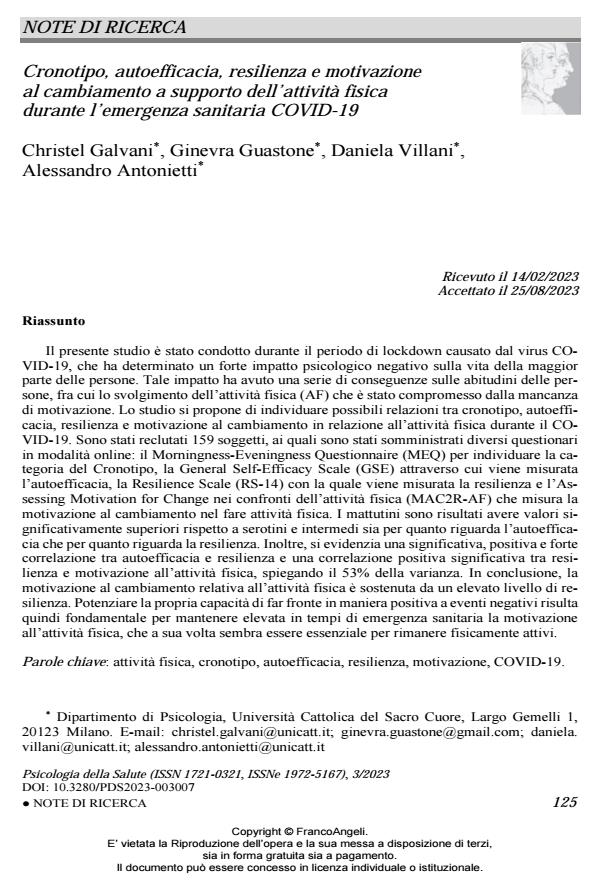Cronotipo, autoefficacia, resilienza e motivazione al cambiamento a supporto dell’attività fisica durante l’emergenza sanitaria COVID-19
Titolo Rivista PSICOLOGIA DELLA SALUTE
Autori/Curatori Christel Galvani, Ginevra Guastone, Daniela Villani, Alessandro Antonietti
Anno di pubblicazione 2023 Fascicolo 2023/3
Lingua Italiano Numero pagine 12 P. 125-136 Dimensione file 208 KB
DOI 10.3280/PDS2023-003007
Il DOI è il codice a barre della proprietà intellettuale: per saperne di più
clicca qui
Qui sotto puoi vedere in anteprima la prima pagina di questo articolo.
Se questo articolo ti interessa, lo puoi acquistare (e scaricare in formato pdf) seguendo le facili indicazioni per acquistare il download credit. Acquista Download Credits per scaricare questo Articolo in formato PDF

FrancoAngeli è membro della Publishers International Linking Association, Inc (PILA)associazione indipendente e non profit per facilitare (attraverso i servizi tecnologici implementati da CrossRef.org) l’accesso degli studiosi ai contenuti digitali nelle pubblicazioni professionali e scientifiche
Il presente studio è stato condotto durante il periodo di lockdown causato dal virus CO-VID-19, che ha determinato un forte impatto psicologico negativo sulla vita della maggior par-te delle persone. Tale impatto ha avuto una serie di conseguenze sulle abitudini delle persone, fra cui lo svolgimento dell’attività fisica (AF) che è stato compromesso dalla mancanza di mo-tivazione. Lo studio si propone di individuare possibili relazioni tra cronotipo, autoefficacia, resilienza e motivazione al cambiamento in relazione all’attività fisica durante il COVID-19. Sono stati reclutati 159 soggetti, ai quali sono stati somministrati diversi questionari in modali-tà online: il Morningness-Eveningness Questionnaire (MEQ) per individuare la categoria del Cronotipo, la General Self-Efficacy Scale (GSE) attraverso cui viene misurata l’autoefficacia, la Resilience Scale (RS-14) con la quale viene misurata la resilienza e l’Assessing Motivation for Change nei confronti dell’attività fisica (MAC2R-AF) che misura la motivazione al cam-biamento nel fare attività fisica. I mattutini sono risultati avere valori significativamente superiori rispetto a serotini e intermedi sia per quanto riguarda l’autoefficacia che per quanto ri-guarda la resilienza. Inoltre, si evidenzia una significativa, positiva e forte correlazione tra au-toefficacia e resilienza e una correlazione positiva significativa tra resilienza e motivazione all’attività fisica, spiegando il 53% della varianza. In conclusione, la motivazione al cambiamento relativa all’attività fisica è sostenuta da un elevato livello di resilienza. Potenziare la pro-pria capacità di far fronte in maniera positiva a eventi negativi risulta quindi fondamentale per mantenere elevata in tempi di emergenza sanitaria la motivazione all’attività fisica, che a sua volta sembra essere essenziale per rimanere fisicamente attivi.
Parole chiave:attività fisica, cronotipo, autoefficacia, resilienza, motivazione, COVID-19.
Christel Galvani, Ginevra Guastone, Daniela Villani, Alessandro Antonietti, Cronotipo, autoefficacia, resilienza e motivazione al cambiamento a supporto dell’attività fisica durante l’emergenza sanitaria COVID-19 in "PSICOLOGIA DELLA SALUTE" 3/2023, pp 125-136, DOI: 10.3280/PDS2023-003007